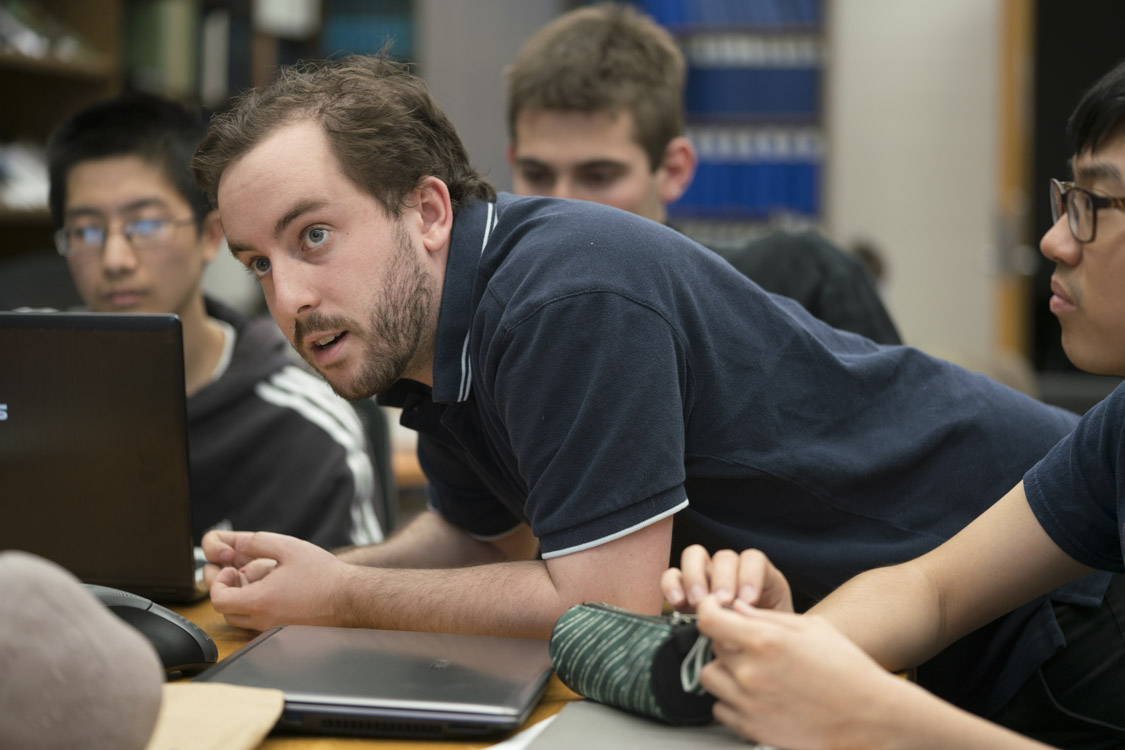Mars 2020 mission: Students survey rover landing sites
By Blaine Friedlander


Meeting weekly this semester for the Astronomy 6500 seminar, Cornell undergraduate and graduate students are conducting research – with six other universities – to help NASA and the Jet Propulsion Laboratory determine a rover landing site for the Mars 2020 mission.
The course is a hybrid experiment that combines research with discussion among schools via teleconferences and electronic conversation by way of Google Groups.
In February, the Cornell students gave a presentation – beamed via teleconference to the other universities – discussing Mars’ Holden Crater, one of the eight potential landing sites being considered for the Mars 2020 rover. That possible landing site in Mars’ southern hemisphere is about 100 miles across and holds clues to a geologic history of running water, evidence of deep gullies, stream beds and a string of lakes.
“Cornell’s seminar presentation was actually passed on to the NASA Mars 2020 mission scientists, who are making the actual decision,” said Alexander Hayes, assistant professor of astronomy, who teaches the Cornell portion of the seminar. “Holden Crater was in danger of being kicked off the list. As of now, however, it is still under consideration. I’d like to think that the students' presentation might have contributed to that decision. If so, that’s quite an accomplishment.”
The Cornell students taking Mars 2020 Seminar: Scientific Issues in Mars Landing Site Selection work with undergraduate and graduate students from Arizona State University, the California Institute of Technology, Purdue University, Stony Brook University, Western Washington University and the University of Copenhagen. Each university analyzes the various landing sites against a rubric that evaluates their suitability to the Mars 2020 project, which will save surface samples for a future return-mission to Earth – and then presents its findings to the other schools. The groups then discuss the pros and cons of each landing site, focusing on each site’s ability to preserve biologic material, and to provide suitable geological and chronological context to understand the environment for the saved surface samples.
Aside from working with the world’s greatest Mars experts, the seminar offers students an opportunity to work on a project that other students – decades into the future – will read about in astronomy textbooks.
Thomas Gautier ’15 wanted to understand the needs of astronomers and planetary scientists. His current engineering master’s research focuses on how light behaves when reflected off various minerals, which has applications for remote sensing.
“While I don’t have the geologic background, I’m interested in the data used in landing-site selection, so I can be aware of the needs of planetary scientists and how to design my research to provide the most useful results,” said Gautier.
In April, Cornell students presented another candidate landing site, Mawrth Vallis, which sits at the boundary between the southern highlands and northern lowlands of Mars – pocked by a spillway sculpted by enormous floods. The students concluded that Mawrth Vallis (the Welsh word for Mars and the Latin word for valley) – though interesting – was not a great landing spot, since there was no obvious context for how and when the extensive phyllosilicate deposits found at the site, a mineral associated with water, were emplaced.
Glynis Perrett, a postdoctoral researcher, has worked on the Mars Science Laboratory/Alpha Particle X-ray Spectrometer team and said landing site determination is fascinating, learning through the course that selection is not straightforward and can be subjective.
“Scientists with backgrounds in geochemistry or mineralogy, for example, will likely favor diverse mineralogical places like Mawrth Vallis or NE Syrtis,” Perrett said. “Other scientists who are more interested in geomorphology may prefer the landing sites that show extensive evidence for past fluvial – that is, water – activity.”
Perrett continued, “It’s really important to hear from many individuals with diverse backgrounds to learn about each landing site. It is then important to compare the landing sites from an unbiased perspective in the context of the mission goals.”
Media Contact
Get Cornell news delivered right to your inbox.
Subscribe